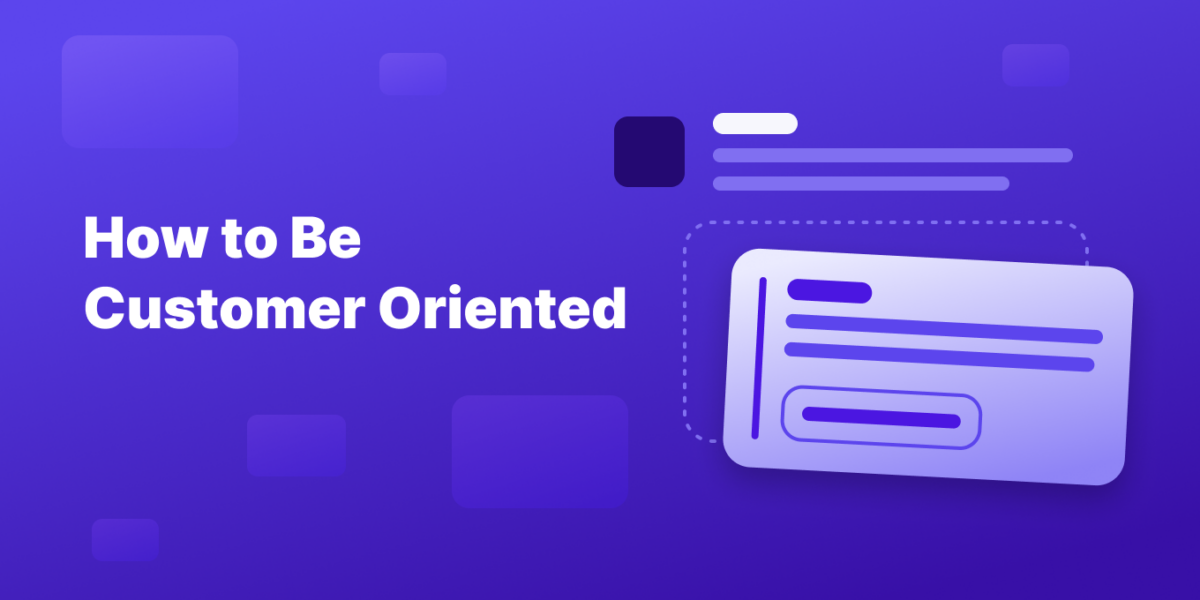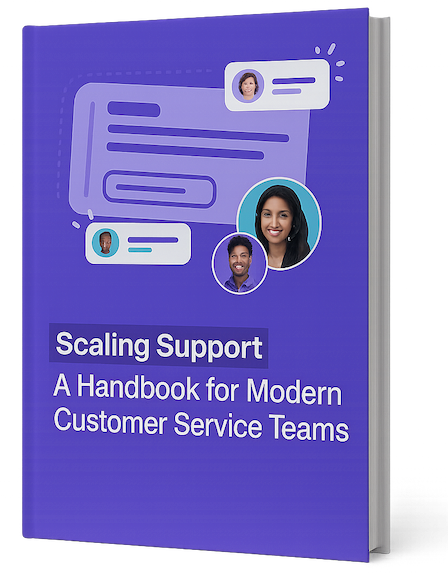A company’s customers are its load-bearing pillars.
They’re vital for making things work in today’s increasingly competitive and oversaturated market and succeeding as a company in any industry.
After all, what would a business be without its customers? You could create the ultimate product or service, think of a fantastic marketing strategy, and fail miserably without proper customer care.
Fortunately, that’s precisely where customer -oriented culture comes in. The core characteristic of this strategy revolves around helping users and providing the necessary care on which so many things ride.
By the end of this article, you’ll know what a customer oriented organization is and the advantages of this strategy.
We’ll also show you examples of such companies and discuss how to implement such a system in your business.
Placing customers first – what is a customer-oriented culture?
Simply put, a company with a customer-first system uses a strategic business approach that prioritizes its users’ needs.
While it sounds straightforward, the importance of such an approach is tremendous. It’s the be-all and end-all of success, as customer oriented culture includes a complete understanding of people interested in your offerings and a focus on providing the ultimate experience for these users.
Examples of such an approach include empathetic listening and dedication to promptly solving your customers’ problems, which can go a long way in building a customer-focused reputation.
These elements further contribute to your sales and customer success, making them exceptionally important for any business, regardless of the industry.
By continuously providing high-quality service and delighting your customers, you ensure their utmost satisfaction and portray your organization as reliable. While it might not skyrocket your profits now, it’s a far better strategy in the long run.
What does it mean to be customer-oriented?
From creating the ultimate customer experience to significantly increasing user satisfaction to building a loyal user base, there are many advantages to a customer-oriented approach, and they can massively benefit your company in the long run. Let’s dive into these elements and see what you could gain from implementing such a strategy in your business.
1. A customer-oriented approach creates a unique customer experience for every user
One of the primary focuses of a customer centric approach is the ultimate customer experience it creates. Even if your users aren’t thrilled with the product, providing appropriate care alongside your services can increase customer satisfaction and build loyalty.
These benefits can be best obtained through a comprehensive customer support knowledge base. After all, understanding customer needs with such a powerful system is effortless.
It helps your teams quickly obtain insightful customer profiles, allowing them to treat each customer individually with diverse care strategies and personalized communications.
Ritz-Carlton is a perfect example of a company that adopted such an incredibly beneficial customer-first approach. Although it’s a luxury hotel and resort company that values tradition and an offline approach, the organization uses intelligent tech systems daily. Its staff often use CRM platforms to note important customer information, which they can quickly pull later to create a personalized customer experience.
Monday Sales CRM is an example of a CRM system that can effortlessly help companies create diverse customer service workflows and manage relationships with their users. However, many similar CRM platforms also exist, and they’re worth investigating.
2. A customer-oriented approach establishes a loyal, devoted customer base
For a customer, purchasing something isn’t just about getting a high-quality product or service. It’s also about how that purchase makes them feel.
A company primarily focusing on a customer-oriented approach will undoubtedly make its users feel more appreciated and understood, inspiring trust in the business.
These elements further create a group of loyal customers ready to purchase again just for that fantastic feeling they’ve experienced.
Getting to that state can be challenging but far from impossible. It requires meeting customer needs and understanding their unique preferences at every step of their journey on your platform. That also means your business will require much work before you become known for fostering trust and satisfaction.
You’ll have to invest in and prioritize personalized experiences to achieve that level of loyalty and user satisfaction. However, that’s certainly worth it in the long run, as adopting such a system can significantly help your business gain a better reputation and higher profits later.
3. A customer-oriented approach increases customer satisfaction
Achieving high levels of user satisfaction can tremendously benefit a business, but it also takes a lot of effort. You’ll have to adopt the customer-centric culture fully, often involving detailed follow-ups with your users. While these check-ins will undoubtedly require more time and effort, they also enhance customer satisfaction, making your users feel important, which is what this approach is all about.
Consequently, completely understanding customer expectations and needs often involves tracking customer satisfaction levels from start to finish and even further.
These actions can also ensure dissatisfied users don’t turn into enraged ones, as a few negative reviews can effortlessly and permanently ruin your reputation in today’s interconnected online world.
Continuously meeting customer needs and showing that you care about your users proves that your company can be trusted and builds loyalty and respect.
Even with an additional strain on your customer support team or with automated solutions that feel more personalized than a chatbot, these actions can quickly lead to increased customer loyalty, benefiting your organization in the long run.
How do you implement a customer-oriented culture into your organization?
Now that we know more about customer-oriented culture, its massive importance, and the advantages of putting customers first, we can move to the implementation steps and discuss how your organization can efficiently adopt such a system.
Train your customer support teams about what matters
While the entire company must share the same goal of putting users first, your customer support team is the first line of defense here. As a result, implementing such a system starts with them, and their training, which should include a deep dive into their background information, is paramount to adopting a customer-oriented approach.
Contrary to popular belief, working as a customer support agent requires more than kindness. Whether hiring new employees or training existing ones, the first few steps should always include finding people with essential customer service skills.
Problem-solving skills are a fantastic example, as this ensures the timely resolution of issues and satisfied customers.
An empathetic customer support team can also go a long way. This necessary element helps build an environment where users feel understood even if a problem can’t be solved.
Knowing how to neutralize a sticky situation and not take things personally is crucial for any team member. After all, you’re bound to have a few disgruntled users who aren’t polite and start swinging left and right when they’re upset, regardless of how long you’ve been in the industry.
Encourage regular customer feedback & gather data
Training your employees and implementing robust AI-based systems for various customer support team use cases isn’t the only way to enhance your customer-centric business approach. After all, getting information directly from your users is also critical.
Here, companies can encourage continuous customer interaction and ensure they’re regularly collecting feedback with the help of the following elements:
- Customer Surveys – Conducting market research with well-thought-out and detailed surveys can help you quickly gain insights into your customers’ unique preferences, allowing you to adjust your approach adequately.
- Social Media – Most of your users are active on social media platforms. That makes managing social media accounts of your own vital for building a better online presence, showcasing your offerings through well-made campaigns and ads, interacting with customers in a more relaxing environment, and regularly collecting feedback for future improvements.
- Feedback Forms – Implementing these elements on your website shows that you’re not stuck in your ways and care about your users’ wants and needs. As a result, these feedback forms involve customers in your decision-making processes and encourage users to share what they like or dislike without being too protruding.
With these strategies, you’ll quickly gain insight into valuable information, such as your users’ opinions. These elements allow you to take your customer-centric approach to the next level and better cater to your customers’ needs.
Adjust strategies & be flexible to meet customer expectations
Incorporating feedback forms and other strategies for gaining insight is incredibly beneficial to running a modern-day business and understanding needs.
However, it doesn’t do much without business flexibility. You’re not exactly showing a customer-centric approach matters much to your organization if you’re not prepared to make the necessary changes.
On the other hand, showcasing your ability to adapt to changing market terms and user needs is one of the tell-tale signs that your company puts its customers first. This flexibility is pivotal and proves you can meet customer expectations, regardless of the situation.
Combining this adaptability with the abovementioned insights significantly benefits your organization. From meeting preferences to tailoring products depending on the market conditions, aligning business strategies with your customers’ needs shows you understand and can anticipate what your users want. These actions prove you’re actively incorporating feedback into your products and services.
Such a flexible organization will always do better than a business that expects things to happen the other way around. As a result, these strategy alignments differentiate your company from the competition, portraying you in a more positive light and improving overall customer satisfaction in the long run.
The importance of customer feedback
By now, you undoubtedly understand the importance of continuously gathering customer feedback. While we’ve mentioned a few basic techniques when discussing how companies should encourage it, this section will dive deeper into information-gathering methods and explore the limitations of various strategies for collecting precious insights.
Gathering feedback from customers
In addition to the abovementioned techniques, there are countless other methods for gathering feedback.
After all, CSAT surveys and social media campaigns are often tedious and cause users to intentionally provide false answers just because they’re annoyed or bored. As a result, these feedback-gathering techniques can also prove limited and lead to worse results than you’d expect.
On the other hand, focus groups are often a fantastic solution for prodding the market and getting valuable information from your users.
They help organizations understand their customers by creating carefully calculated age, gender, and sex groups, asking elaborate questions from each group, and analyzing the results. However, they’re also much more complicated to set up and require more time and effort.
Direct customer communication is another way of gathering feedback. You can use these highly-targeted methods in a few different ways. For example, some companies rely on phone calls, either having lines customers can call 24/7 or taking a more proactive approach and placing cold calls. Mail and email listings also fall into this category.
However, since these are highly targeted communication methods, their reach is far smaller than that of mass social media ads.
Help Your Customer Support Team Find The Info They Need with Tettra
Tettra offers a transformative solution for customer support teams, streamlining internal knowledge management.
By integrating quickly with tools like Slack and MS Teams, Tettra enables teams to quickly access and share crucial information, enhancing response times and consistency.
Its AI-powered knowledge base simplifies documenting and updating procedures, ensuring support staff have up-to-date, accurate information at their fingertips.
This leads to more efficient problem-solving and a more cohesive, informed customer support experience.


